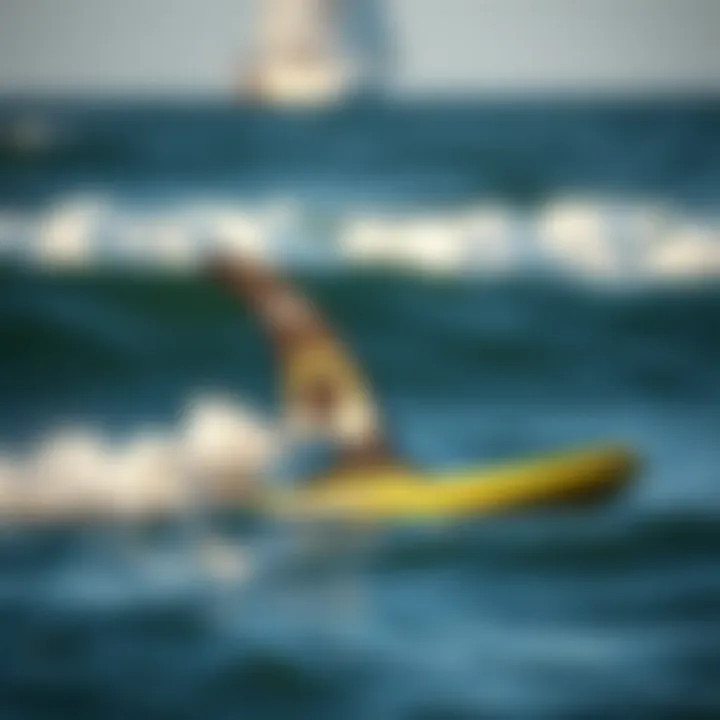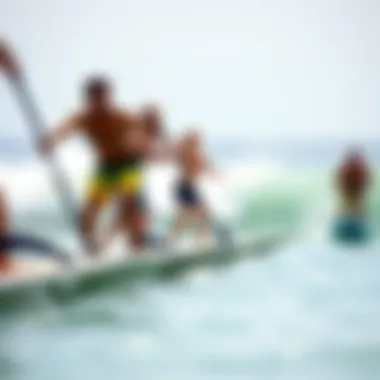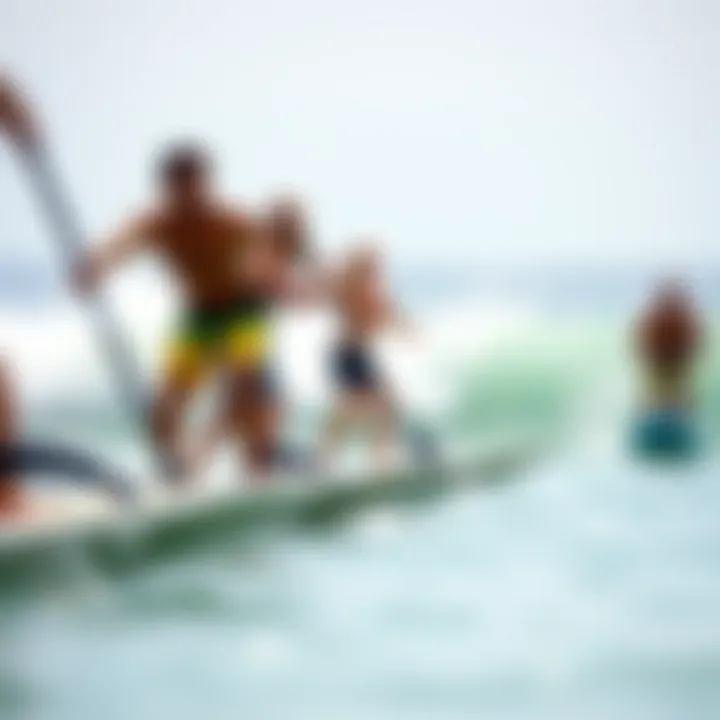Exploring Motorized SUP Fins: Revolutionizing Water Sports


Intro
As water sports continue to evolve, the introduction of motorized stand-up paddleboard (SUP) fins marks a significant turning point in how enthusiasts engage with this pastime. Traditional paddleboarding, while invigorating and often meditative, can sometimes be constrained by a paddler's physical stature and stamina. Motorized SUP fins change this narrative. They offer a blend of innovation and freedom, enabling riders to traverse further distances, explore previously unreachable spots, and even engage in new types of maneuvers on the water. This shift prompts a closer examination of not only the technical facets but also the cultural ramifications that this sparkling gadget brings into the surfing community.
Surfing Techniques
The advent of motorized SUP fins necessitates a fresh look at both basic and advanced paddleboarding techniques. While some may argue that the essence of the sport is about raw skill and connection to the water, motorized fins can enhance that experience significantly.
Mastering the Basics
To get started, paddlers need to embrace the simple joys of balancing and paddling. Motorized fins don’t replace these fundamental skills; instead, they amplify them. Here’s how to master the basics:
- Balance and Stability: Begin by finding your center of gravity. As you stand on the board, keep your knees slightly bent and your feet shoulder-width apart. This stance helps in maintaining stability while managing the motor's assistive power.
- Engaging the Motor: Understanding how to operate the motor is crucial. Most devices are equipped with an intuitive control system. Familiarize yourself with the throttle and directional features before heading out into deeper or choppier waters.
- Paddling Techniques: Even with a motor, paddling is vital. When starting off or coming to a stop, using your paddle will help maintain control. Practice switching between paddling and utilizing the motor to develop a seamless technique.
Advanced Maneuvers
Once you’ve got the hang of the fundamentals, it’s time to explore some advanced maneuvers that motorized SUP fins can facilitate:
- Speeding Up and Slowing Down: By mastering these controls, you can learn how to use the motor for quick bursts of speed, ideal for catching waves or navigating through currents. Slowing down is equally valuable for maintaining a graceful turn or taking a scenic dip.
- Turbulence Navigation: Equipped with a motor, the ability to tackle rough conditions changes dramatically. You can engage the motor to cut through choppy waters while practicing tight turns and maneuvering around obstacles.
- Tricks and Stunts: Obstacle courses and ramps suddenly become possibilities. While extreme tricks might still require traditional paddleboarding skills, the added propulsion allows for thrilling creative expression on the water.
Surfing Lifestyle
Beyond the techniques, motorized SUP fins also paint a broader picture of surf culture, touching on sustainability, community, and adventure.
Sustainable Surfing Practices
As with any technological advancement, sustainability is key. While a motorized SUP fin may not fall under traditional "green" practices, there are ways to make its usage environmentally friendly:
- Eco-Friendly Materials: Look for brands that emphasize sustainable production—things like recyclable materials or renewable energy sources in the battery design.
- Battery Disposal and Recycling: With any electric device, responsible disposal and recycling of the battery are crucial. Finding local programs that handle this can minimize environmental impact.
Surf Culture Around the World
Motorized SUP fins are not just technical tools; they are becoming part of a larger narrative within the global surfing community:
- Diverse User Groups: From athletes in Hawaii to recreational paddlers in California, the appeal cuts across age and skill levels. New users approach water sports with a sense of curiosity and excitement.
- Community Building: Various communities have started to create riding events focused on motorized SUP fins, fostering camaraderie. These gatherings help enthusiasts share tips, experiences, and a newfound appreciation for the additional freedom afforded by technology.
- Cultural Exchange: As motorized fins gain traction globally, the fusion of styles and local practices enriches the culture of surfing. This exchange can lead to innovative techniques and a broader understanding of wave riding.
Preface to Motorized SUP Fins
Motorized stand-up paddle (SUP) fins introduce a groundbreaking combination of technology and water sports, aiming to enhance the experience of both novice and seasoned paddlers. As interest in water sports continues to grow, these innovative fins present a compelling case for the future of aquatic recreation. These devices not only bring speed to the adventure but also offer new experiences that traditional paddling can't match.
Definition and Functionality
Motorized SUP fins can be described simply as fins equipped with a propulsion system that allows the board to move with minimal effort from the user. They operate on battery power, often utilizing electric motors to generate thrust. Think of them as the perfect blend of a surfboard and a jet ski, allowing riders to glide across water with ease.
The primary functions of motorized SUP fins include:
- Assisted Propulsion: They provide a boost that can propel the board at higher speeds compared to traditional paddling.
- Customization of Riding Experience: Users can select different speed settings depending on their skill levels and objectives.
- Efficiency in Long-Distance Paddling: These fins help optimize energy expenditure, making longer trips on the water less tiring.
With these enhancements, paddlers can navigate a variety of waters, from calm lakes to light ocean waves. The importance of this innovation in paddleboarding is reflected in how it reshapes the relationship people have with water sports, potentially broadening the appeal of SUP to newcomers.
Historical Context of SUP Technology
To understand the significance of motorized fins, it's essential to glance back at the evolution of stand-up paddleboarding. Traditional paddleboarding has roots dating back to ancient cultures, particularly among Polynesian communities who used them for fishing and transportation. Today, the sport has grown exponentially in popularity, especially in the past couple of decades.
The advent of modern SUP can be traced to the mid-2000s when surfers in Hawaii began utilizing wider and thicker boards, making it easier for paddlers to balance and navigate. This transformation laid the groundwork for diverse applications of paddleboarding—contributing to fitness, relaxation, and competition.
As technology continues to evolve, innovations like the motorized SUP fin embody the spirit of adaptation in water sports. They are a reminder that just as the sport itself developed from tradition into a contemporary pastime, so too can the tools of the trade evolve to expand the horizons of what paddlers can achieve on the water. This revolutionary approach is not merely a trend; it's a natural progression, seeking to meld performance with accessibility in the world of water sports.
Design Features of Motorized SUP Fins
The design features of motorized SUP fins play a pivotal role in enhancing not just the functionality of the boards, but also the overall experience of paddleboarding. As the sport grows more intricate and diverse, the ingenuity behind these fins beckons attention. The area where engineering meets artistry results in components that not only serve specific functionalities but also contribute to the aesthetic appeal of the boards. This section will delve into the key components that characterize motorized SUP fins, exploring the materials used in their construction, the technological components they encompass, and the aerodynamic factors that ensure optimal performance.


Materials Used in Construction
When manufacturing motorized SUP fins, the choice of materials is foundational. Lightweight yet durable substances come into play, ensuring the fins can withstand the rigors of water sports while also providing the necessary buoyancy. Common materials include high-density plastic, with some fin manufacturers opting for carbon fiber or fiberglass, each offering unique advantages.
- High-Density Plastics: Known for its resilience, this material is cost-effective and allows for versatile designs. It’s easy to mold into various shapes, making it a favorite among manufacturers.
- Fiberglass: Fiberglass fins are known for their strength-to-weight ratio. The flexibility in their construction enables a smoother experience as they cut through water.
- Carbon Fiber: This premium material is hailed for its lightweight properties and incredible durability. Although pricier, carbon fiber fins offer the advanced surfer superior performance while maintaining agility on the water.
Each of these materials contributes significantly not just to strength and performance, but also impacts the environmental footprint of the fins during their lifecycle.
Technological Components
When we talk about technological components, we are exploring a treasure trove of engineering marvels that enhance user experience. Motorized SUP fins can incorporate various technology features that provide better control, performance monitoring, and even connectivity to mobile devices.
Here are a few technological elements one can typically find in motorized SUP fins:
- Power Systems: Many fins are equipped with compact electric motors powered by rechargeable batteries. These motors engage users with adjustable power settings, allowing for different speeds depending on rider skill and preferences.
- GPS and Performance Monitors: Some advanced fins include GPS capabilities which can track distance travelled and speed. This data can be invaluable for athletes looking to improve their performance.
- User Interfaces: A rise in smart technology has lead to fins that connect to smartphones via Bluetooth. Riders can modify settings and monitor metrics in real-time, creating a more interactive experience on the water.
The integration of these components not only enhances the efficiency of the fins but also brings a new level of engagement to paddleboarding.
Aerodynamic Considerations
Aerodynamics plays a surprisingly critical role in the performance of motorized SUP fins. The design must consider hydrodynamics to minimize drag as the fin slices through water. A fin engineered with effective aerodynamic features can drastically improve speed and maneuverability, ensuring the surfer glides effortlessly across various water conditions.
Factors to consider in aerodynamic design include:
- Shape and Profile: The contour of the fin significantly affects water flow. A well-designed fin should feature a streamlined shape that reduces resistance, allowing for better acceleration.
- Aspect Ratio: This is the ratio of the fin's height to its width. A higher aspect ratio fin typically has superior performance in flat water, whereas a lower ratio may offer more control in choppy conditions.
- Surface Texture: Textured surfaces can create a smoother water flow, reducing turbulence and enhancing performance even further.
Ultimately, the blending of advanced materials, cutting-edge technology, and smart aerodynamic design culminates in motorized SUP fins that not only elevate the sport but also promise a transformative experience for paddlers.
Advantages of Using Motorized SUP Fins
The integration of motorized fins into stand-up paddleboards marks a significant leap forward in the evolution of water sports. Understanding the advantages of these innovations is essential for enthusiasts who are keen to maximize their experience on the water. Motorized SUP fins not only enhance performance but also open up new avenues for participation in aquatic activities, paving the way for a broader audience to embrace paddleboarding.
Enhanced Maneuverability
One of the standout features of motorized SUP fins is their capability to allow for enhanced maneuverability. Traditional paddleboarding demands considerable skill in balancing and navigating through variable water conditions. In contrast, with a motorized fin, riders experience a newfound ease of steering and turning. Imagine surfing through choppy waters with less strain, deftly avoiding obstacles with a flick of the wrist. The turbocharged responsiveness provided by the motor means that even novice paddlers can handle tricky situations without feeling overwhelmed.
The design of these fins incorporates intuitive controls that allow users to adjust speed and direction seamlessly, lending a hand to even those who might not have mastered traditional paddling techniques. The result? More fun and less frustration on the waves for everyone, irrespective of their paddling prowess.
Greater Speed and Efficiency
Speed is the name of the game when it comes to motorized SUP technology. Riders can cover significant distances in less time compared to manual paddling, which can be grueling, especially over long treks. With the push of a button, users can summon speed that rivals that of traditional watercraft without the exhausting physical effort.
This added efficiency can transform your water adventures, enabling users to explore farther reaches of lakes, rivers, or coastlines without becoming fatigued. Boasting well-engineered brushless motors, many models provide a speed that can reach up to 5-6 miles per hour, pushing the limits of traditional paddleboarding.
"With a motorized SUP fin, a short Saturday afternoon excursion turns into a full-on adventure!"
For environmentally-conscious adventurers, it is worth noting that the efficiency boosts also serve to conserve energy. Riders can enjoy longer outings without becoming worn out, and the quieter propulsion systems minimize disruptions to wildlife and the surrounding environment.
Accessibility for Various Skill Levels
Motorized SUP fins break down barriers, making stand-up paddleboarding accessible to a more diverse group of people. Enthusiasts, whether young, senior, or simply inexperienced, can engage in the sport without the steep learning curve that typically deters newcomers. The motor assists all kayakers in facilitating movement on the water, which is particularly advantageous for those with physical limitations.
Moreover, families can now paddle together with varied skill levels without leaving any member behind. Imagine a relaxing day at the beach, where the experienced paddlers can make headway while the less experienced enjoy a leisurely float yet still stay together as a group. This newfound inclusivity not only enhances the social aspect but breathes fresh life into community engagement, inspiring group outings and shared experiences.
Challenges and Concerns
The rise of motorized SUP fins has opened up exciting avenues for water sports enthusiasts, but it also presents a set of challenges that can't be overlooked. Understanding these hurdles is crucial for surfers and industry stakeholders alike. As we analyze the environmental impact, regulatory considerations, and maintenance aspects, we can better navigate this new wave of technology while keeping our oceans and communities in mind.
Environmental Impact
One pressing concern with motorized SUP fins is their environmental footprint. While paddleboarding is traditionally seen as a low-impact activity, the introduction of motors changes that narrative. The engines can contribute to pollution in several ways:


- Gas Emissions: Depending on the type of motor used, emissions can adversely affect air quality. Even electric motors, though cleaner in operation, require energy, which often comes from non-renewable sources.
- Noise Pollution: The serene sounds of nature are often drowned out by the whirring of motors. This can disrupt aquatic life and deter marine species from their natural habitats.
- Battery Disposal: For electric options, the handling and disposal of batteries pose a significant concern. If not managed correctly, they can lead to contamination in waterways.
To tackle these issues, manufacturers must embrace sustainable materials and designs, as well as promote environmentally friendly practices within the industry.
Regulatory Considerations
With innovation often comes a host of regulations and guidelines that may not yet be in place for newer technology like motorized SUP fins. This absence could lead to confusion among users and potential risks. Considerations include:
- Licensing Requirements: Some regions might demand specific licenses or registrations for operating motorized watercraft, potentially alienating casual users unaware of these regulations.
- Restricted Areas: Local laws may prohibit motors in specific waterways to maintain tranquil environments or protect wildlife. Knowledge of these regulations is essential to avoid fines or penalties.
- Safety Standards: The lack of established safety protocols can place users at risk, particularly if proper instructions for use and maintenance are not widely communicated.
The industry would benefit from clear, updated regulation concerning motorized SUPs to safeguard both users and the ecosystem.
Maintenance and Durability
Even the best technology has its kinks, and motorized SUP fins are no exception. Regular maintenance is vital for ensuring these devices function optimally and safely. Key maintenance concerns include:
- Wear and Tear: Motors may require routine checks to prevent malfunctions. From replacing propellers to inspecting motor housing, owners must stay vigilant to avoid costly repairs.
- Water Resistance: Ensuring that components are adequately sealed against moisture is crucial for durability. Prolonged exposure to saltwater can accelerate corrosion and degrade performance.
- Battery Management: For electric motors, proper charging practices and battery maintenance are essential. Neglected batteries can result in short life spans and potential safety hazards.
As motorized SUP technology matures, a well-planned maintenance strategy will help users maximize their investments while promoting longevity in product life.
"The challenges facing motorized SUP fins are as critical to the sport’s future as the innovations that drive them. Awareness and proactive measures can help keep water sports thrilling, safe, and environmentally sound."
Addressing these challenges will not only ensure a positive experience for paddlers but also help preserve the integrity of aquatic environments.
Comparative Analysis: Traditional vs. Motorized SUP
When examining the world of stand-up paddleboarding (SUP), it's crucial to compare traditional methods against new motorized advancements. This comparison goes beyond mere numbers; it spotlights real-world, everyday experiences. As water sports evolve, understanding the nuances between traditional paddleboards and their motorized counterparts helps enthusiasts gauge what each offers.
Performance Metrics
In assessing performance, several metrics surface. Key statistics often looked at include:
- Speed: Traditional SUPs generally require considerable effort and technique to achieve notable speeds. In contrast, motorized SUP fins can boost speed to record heights with minimal physical exertion. However, it's essential to remember that speed alone does not define a good experience on the water.
- Range: With motorized fins, the range can increase significantly. While a traditional paddleboard may allow for leisurely distances that depend on paddling stamina, motorized SUPs can cover larger waters without exhausting the rider.
- Stability: A traditional board often provides a stable ride thanks to its design and user-control. Yet, motorized fins change dynamics, sometimes leading to instability at higher speeds. Balancing this technology requires practice.
In essence, while motorized versions shine in speed and range, traditional boards offer steadiness that many paddlers cherish.
User Experience
Diving deeper into user experience reveals a tapestry of preferences driven by diverse needs.
- Novice vs. Experienced Riders: Beginners might find motorized SUPs alluring due to ease of use. With a smooth throttle and a quicker learning curve, novices can focus on enjoying the water rather than struggling with technique. On the flip side, traditional paddleboarding allows experienced riders to hone their skills, push boundaries, and enjoy the purer elements of paddling.
- Connection to Water: For purists, the essence of paddling is closely tied to feeling every ripple and wave. Traditional boards reinforce that intimacy with nature as paddlers feel they are a part of the water itself. With motorized options, this connection may seem diluted, with riders leaning more on technology than their body's strength.
- Social Factors: The rise of motorized SUPs opens new channels for group activities and events. With increased speed, riders can travel together more efficiently or explore larger bodies of water. However, some may argue that motorized fins detract from the spirit of community found in traditional paddleboarding.
Ultimately, the user experience often boils down to individual preferences and what riders seek from their time on the water. Whether one values the long-standing traditions of paddleboarding or embraces modern innovation, there's room for both in this vibrant community.
"The beauty of water sports is that it evolves, but the soul often remains unchanged."
In closing, comparing traditional paddleboards with motorized SUPs reveals a spectrum of experiences, capabilities, and emotional connections. Embracing the new without disregarding the traditional offers adaptability and perpetuates interest within the surfing community.
Cultural Implications in the Surfing Community
The emergence of motorized SUP fins is more than just a technological marvel; it's a shift that reverberates through the very fabric of the surfing community. At its core, culture is made up of shared beliefs, values, and behaviors. The arrival of these motorized fins is bound to stir the pot in ways that can shape the future of paddle sports as we know it. This innovation introduces new dynamics into an activity steeped in tradition, and understanding these implications is crucial for enthusiasts and purists alike.
Acceptance Among Purists
One of the most significant aspects of the discussion around motorized SUP fins is the reception from surfing purists. For those who cherish the essence of traditional paddling, the idea of adding a motor can seem like a betrayal of the sport's roots.
- Tradition versus Modernity: Many regard stand-up paddleboarding as a way to connect with the environment. The simplicity and tranquility of gliding over water with just a paddle has its unique charm. The thought of a motor whirring away can dilute that experience.
- Authenticity Concerns: Those who have spent years perfecting their stroke may feel that motorized boards skew the authenticity of the sport. There's a sentiment that true skill lies in physical effort and understanding one’s own balance and reaction to the water.
- Open-minded Perspectives: However, there is a growing faction that embraces the idea. Some see it as an enhancement, perhaps allowing individuals with physical limitations greater access to the joys of paddleboarding. This perspective represents a beneficial evolution rather than a destruction of tradition.
Whether or not motorized fins gain traction among die-hard traditionalists will ultimately depend on how well they can balance innovation with respect for the long-held values of the surfing culture.
Emergence of New Riding Styles


As motorized SUP fins evolve, they introduce an array of new riding styles that may redefine the sport. There are suggestions that these fins will lead to creative expression on the water, spawning techniques and methods that have never been thought possible.
- Tricks and Maneuvers: With additional power comes the ability to perform advanced tricks. Riders might find themselves catching waves differently or even attempting stunts previously reserved for traditional surfing. This could open the door to competitions that assess creativity alongside speed and skill.
- Hybrid Sports: The merging of paddleboarding with elements of other water sports may become commonplace. Imagine combining elements of jet skiing with SUP, allowing for novel experiences that could attract a diverse audience. This hybridization could even lead new enthusiasts to discover water sports they would never have tried before.
- Community Events: The rise of motorized fins could foster events that celebrate these new styles. Think about unique races or exhibitions that showcase the versatility of the boards while also inviting community participation.
With these new riding styles, we may witness an expansion in the demographic of participants and intro the community, creating a space that may accommodate both the die-hard paddleboarding fans and those curious about the new technological advancements.
The tension between preserving tradition and embracing innovation is a vital conversation in the world of water sports. As with any cultural shift, open dialogue may pave the path for mutual understanding.
Future of Motorized SUP Technology
The future of motorized SUP fins appears to be a thrilling frontier that could redefine how enthusiasts engage with water sports. The incorporation of motorized technology into stand-up paddleboarding isn't just a passing trend; it's an evolution premised on innovation and accessibility. As the sport gains traction globally, understanding the upcoming advancements can offer insights into consumer demands, environmental considerations, and the broader impact on water sports.
Trends in Innovation
Innovation is the lifeblood of progress, and when it comes to motorized SUP fins, several emerging trends are shaping the landscape.
- Battery Technology Improvements: As technology advances, so do power sources. The introduction of lightweight, long-lasting batteries will undoubtedly enhance the entire experience, allowing riders to frolic in the waves for extended periods without running out of juice. Expect to see lithium-ion batteries with higher capacity and faster charging times becoming the standard.
- Smart Features: Imagine being able to connect your paddleboard to a smartphone app for real-time tracking of speed, distance, and even GPS navigation. This integration is becoming increasingly feasible. Moreover, features like cruise control and customizable power settings are already on the horizon, enabling a more tailored riding experience.
- Enhanced Safety Mechanisms: With great power comes great responsibility. Future developments aim to incorporate safety features such as automatic shut-off when the user falls off, or collision detection systems to prevent accidents with other watercraft or obstacles.
"The next wave of innovation in motorized SUP technology is all about blending performance with safety and convenience, ensuring that users can focus on enjoying their time on the water."
- Sustainability Initiatives: Given the increasing environmental consciousness among users, companies are looking into eco-friendly materials and methods of energy sourcing, such as solar-assisted charging mechanisms.
Potential Market Developments
As the interest in motorized SUP technology grows, several market developments are likely to unfold, transforming the landscape for users and manufacturers alike.
- Expansion of Target Audience: Different demographic groups may find motorized paddling appealing. Families looking for leisurely weekend getaways or seniors seeking more accessible options can benefit greatly from this technology. It may open doors for those who have previously found traditional paddleboarding exhausting or intimidating.
- Rental and Experience Markets: More businesses could emerge around motorized SUP rentals, calm-water excursions, and guided tours. The potential for adventure tourism is immense, providing local economies with new avenues for growth.
- Competitive Scene Evolution: With the advent of motorized fins, a new category within competitions could arise, creating a fresh wave of excitement among athletes willing to push the boundaries. Race formats, skill levels, and event categories may diversify as new technologies become mainstream.
- Retail and E-Commerce Integration: Just like traditional paddleboards, the demand for motorized models will fuel e-commerce growth within specialized retail spaces, leading to options for customized configurations or bundled accessories offering riders the full experience at their fingertips.
In summary, motorized SUP technology is on the cusp of significant transformation. The trends in innovation coupled with potential market developments paint an exciting future for water sports enthusiasts. As riding becomes easier and more enjoyable, we can look forward to not only more individuals engaging with the sport but also a deeper harmony with our beautiful waterways.
User Testimonials and Case Studies
User testimonials and case studies serve as the lifeblood of understanding the impact of motorized SUP fins on both individuals and the broader community. These narratives provide real-world insights that transcend theoretical knowledge, granting readers a glimpse into how this innovation is revolutionizing the experience of stand-up paddleboarding. By presenting these personal accounts, the article gains a relatable context, revealing the emotional and practical ramifications of motorized fins on varying skill levels and lifestyles.
As paddleboarding enthusiasts navigate waters with enhancements in speed and efficiency, many individuals have transformative experiences that speak to the essence of the sport. For instance, the stories shared by everyday users can shed light on both the exhilarating and challenging aspects of incorporating technology into a traditionally minimalist sport. This section not only amplifies the voices of those in the community but also serves to contextualize users' interactions with motorized SUP fins.
Individual Experiences
Take, for example, Anna, who recently took her motorized SUP fin out on Lake Tahoe. Previously hesitant because of her self-identified lack of athletic prowess, Anna found the motorized feature a game-changer. "It felt like riding a wave of freedom!" she exclaimed. The ability to easily adjust her speed meant that she could paddle with her friends without feeling left behind. Moreover, she enjoyed the thrill of competing with faster surfers, making her outings all the more enjoyable.
Her experience encapsulates a common sentiment; many novices find confidence in the mechanical support provided by motorized fins. They serve as a bridge between feeling overwhelmed by the sport's physical demands and exploring the waterways with a sense of ease. From practical benefits like increased stability to enhanced navigation abilities, these personal stories underscore the significant shift in user perception and engagement with paddleboarding.
Community Adoption Stories
On a broader scale, community adoption stories reveal how motorized SUP fins are influencing groups and gatherings. In places like Cape Cod, local surf clubs have begun organizing events specifically centered on motorized paddleboarding. Members have reported an uptick in participation. They often reminisce about previous events where paddlers rarely ventured beyond the shore. Now, with this technology, they find it exhilarating to ride longer distances and explore hidden coves and surf breaks that were previously inaccessible.
"More folks are joining in for the sheer fun of it! It's like surfing but with a fresh twist," remarked Mike, a long-time surf instructor who has observed these trends first-hand. The camaraderie built during these meetups highlights an evolving culture, one that embraces both tradition and innovation.
Social media has also played a vital role in amplifying these narratives. Groups on platforms like Facebook and Reddit share their motorized SUP fin experiences, creating rich discussions that explore the benefits, sharing tips, and sometimes even lending support when things go awry.
The End
In summary, the integration of motorized SUP fins represents much more than just a technological advancement; it signifies a paradigm shift in how we engage with water sports. This article has thoroughly examined the multifaceted aspects of these innovative fins, from their distinctive design features to their notable advantages and the challenges they entail.
Summary of Findings
The exploration of motorized SUP fins sheds light on several key findings:
- Enhanced Mobility: These fins allow users to navigate through waterways with unprecedented ease, opening up opportunities for exploration that were previously reserved for the most skilled paddlers.
- Speed and Efficiency: Motorized fins facilitate faster travel over water, which can be particularly advantageous in competitive settings, as well as for leisurely outings. Users can cover longer distances in shorter times, making for richer experiences on the water.
- Inclusivity and Accessibility: Individuals from various backgrounds and skill levels can join the fun, promoting inclusivity in the water sports community. As those with physical limitations can now partake without the feeling of being left out, the cultural implications are significant.
- Environmental Considerations: While there are notable benefits, it is vital to remain vigilant about the potential environmental impacts. As the water sports community adopts this technology, understanding its ecological footprint becomes essential.
Final Thoughts
Motorized SUP fins are not merely a passing trend; they are a reflection of evolving attitudes towards the sport of paddleboarding. As water sports enthusiasts, there is a need to embrace innovation while maintaining respect for the traditions that have shaped our experiences on the water. While recreational paddling will always hold its charm, the emergence of motorized options invites a new audience to partake in this beloved activity.
"Progress must be carefully balanced with respect for our environment and traditions."
As the market continues to evolve and technological advancements introduce even more enhancements, it will be the shared responsibility of the surfing community to navigate this new frontier thoughtfully. By doing so, we can ensure that motorized SUP fins enhance our experiences without jeopardizing the spirit of the water sports we know and love.
For more information on the environmental impacts of water sports, you may refer to EPA's guidelines or explore discussions on Reddit related to paddleboarding. Educating our community on responsible usage can help maintain the balance required for a thriving water sports culture.















